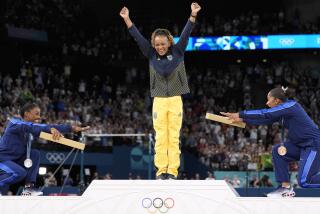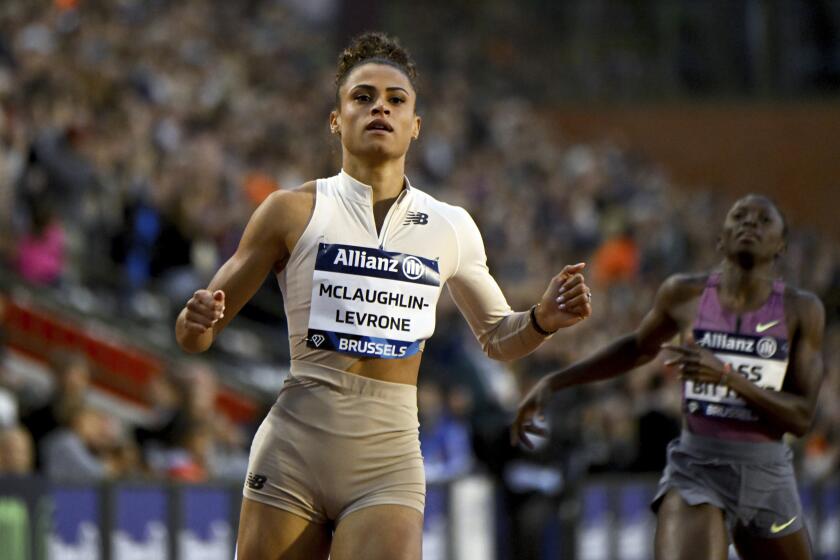Raymond Is Taking Issue With a Doubles Standard
- Share via
CARLSBAD — And they said tennis didn’t have Olympic trials.
The case for Lisa Raymond playing doubles on the U.S. Olympic women’s team eventually could be headed to court. Raymond, the No. 1-ranked doubles player in the world, was passed over in favor of Serena Williams by captain Billie Jean King.
Williams will be playing doubles in Sydney with her older sister Venus. The Williams sisters are the reigning Wimbledon and U.S. Open champions. Raymond won the Australian Open with Rennae Stubbs in January.
But Raymond, who believed she was following the selection guidelines, was upset at her exclusion. She hired Gregory Becker of the Los Angeles-based law firm of Fonda, Hilberman & Fraser, which sent a letter Wednesday to Norm Blake, chief executive of the U.S. Olympic Committee. It notified him of the complaint, “brought under Article IX of the U.S. Olympic Committee Constitution and the grievance procedures for the Code of Conduct for Team Selection.”
“The selection procedures are based on the Women’s Tennis Association ranking as of July 9, 2000,” the letter said. “Ms. Raymond is and was the number 1 ranked doubles player in the world at all relevant times and was excluded from the Olympic team.”
Said Becker: “We’re trying to informally resolve it right now. But the grievance procedure has been initiated. We need to explore certain options--how we want to conduct any potential arbitration. What type of appeal process we expect the USTA to go through.
“That’s one of the things that is really troubling us. We feel very strongly about our position. Lisa would not be taking on the world if she didn’t. We want her to get instated and not have to endure a lengthy appellate battle.”
Monica Seles, who will be playing singles in Sydney, had a feeling there would be controversy in regard to the American selections, which is why she urged her colleagues on the WTA tour to vote for ranking points to be attached to the Olympics. They voted against it.
The men did it on the ATP tour, creating a larger draw and more spots for U.S. players.
“For sure, you knew it would be trouble,” Seles said. She said the vote, at Miami in March, was a close one. Seles doesn’t like to speak out much these days, but she does feel Raymond was wronged and said it again here Friday.
“There weren’t any rules changed in the USTA selection process,” Becker said. “There were rules that were not followed.”
Serena Williams barely missed making the team in singles. Lindsay Davenport, Venus Williams and Seles are higher ranked and will be representing the United States.
“I really wasn’t thinking much about it,” Serena Williams said. “I should be on the team, to be honest. There are a lot of good American players. Obviously, I’m one of them. I definitely should be on the team.”
Raymond said she did what she needed to do to make the team, putting extra emphasis on her doubles ranking at the expense of her singles ranking.
“This isn’t about me and Serena,” she said. “I’m not fighting Serena. I just feel like I’ve earned that spot. I feel I fairly deserve that spot. I really strongly believe that. I just don’t want to let them walk all over me.
“If anything else, whether it’s me or any one else in 2004, hopefully this will not happen again.”
STANDING PAT
It was bound to happen, especially after Patrick Rafter was forced into Davis Cup duty against Brazil in the semifinals immediately after his loss to Pete Sampras in the Wimbledon final. His right shoulder started bothering him again last week in Toronto and Rafter withdrew from this week’s tour event at Cincinnati. He had surgery to repair a torn rotator cuff in the shoulder last fall.
“It’s just not worth me going through the whole pain and trying to push through it,” Rafter said. “I’ve had a lot, a lot of therapy here, worked very, very hard, had a couple hours each day. It’s not getting better. In fact, it’s starting to get worse. So I have to take time off now, if I want to be ready by the U.S. Open.
“The lesson that I learned from the last shoulder thing, the last shoulder problem, was that if it’s not getting any better, while I’m playing, it’s time to take time off. Get it while it’s early. Because if you keep pushing through it, it will just escalate into a bigger problem.”
Additionally, Rafter said he will be carrying the Olympic torch the day before the opening ceremony, around Sydney Opera House.
AMOS, SHLOMO . . . AND HAREL
Until he reached the final at Toronto on Saturday, the most attention Harel Levy of Israel probably received was when he beat Michael Chang in a satellite tournament at Aptos, Calif., last summer.
Levy, whose 22nd birthday was Saturday, is the first Israeli player to make an impact since the days of Amos Mansdorf and Shlomo Glickstein. Levy thanked his supporters in Toronto, but he has always been gracious.
Last year, he went out of his way to meet, and thank, a vociferous fan of Israeli tennis, at a minor event at a small club in Dallas after one of his matches.
QUOTE, UNQUOTE
* “For you, maybe it was good, but for me, I lost 10 years of my life,”--Marat Safin, on the third-set tiebreaker against Sampras in the Toronto quarterfinals. He saved three match points.
* “We want to make tennis a Williams tennis circuit,”--Serena Williams.
* “Well, it was a little light out when we started. And besides, if I took it off, I’d have visor-head,”--Amy Frazier, who was wearing a visor for her night quarterfinal match against Martina Hingis at Carlsbad last week.
More to Read
Go beyond the scoreboard
Get the latest on L.A.'s teams in the daily Sports Report newsletter.
You may occasionally receive promotional content from the Los Angeles Times.







